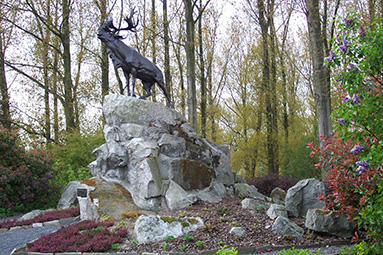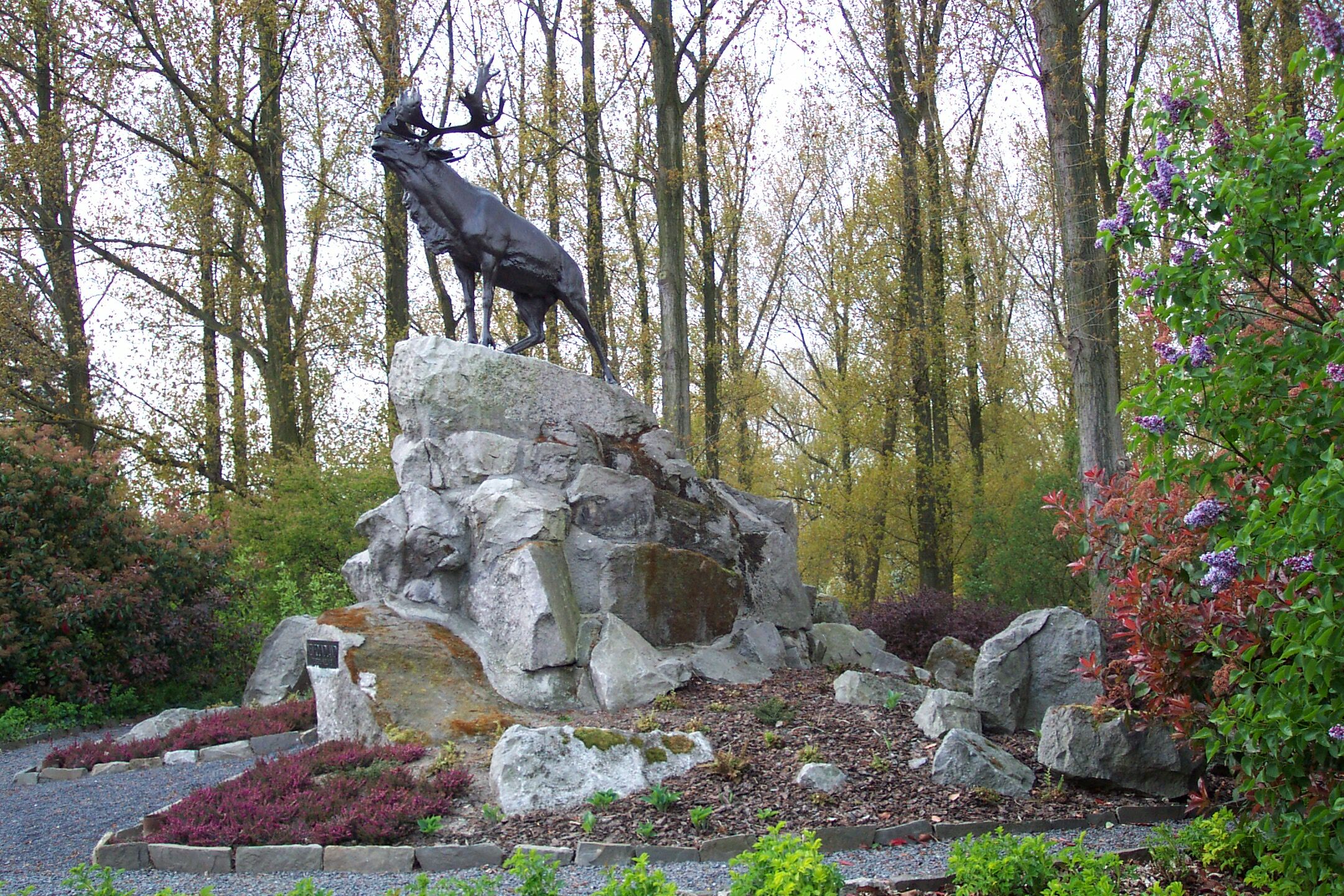The Courtrai Newfoundland Memorial in Belgium, just outside Courtrai on the road to Ghent, is the only caribou memorial in Belgium. In his rocky eminence, the stag commemorates the Royal Newfoundland Regiment's crossing of the Lys River under British divisional command. Today, the visitor can see the bullet marks pitting the base of the Memorial - a tragic reminder of the Regiment's final advance of the war.
The Final Newfoundland Offensive, 1918
During the campaigns of 1918, the Royal Newfoundland Regiment's operations were confined to the northern sector of the Western Front. When the Germans launched their great April offensive, the Regiment fought defensive actions in the Battles of the Lys, adding the name "Bailleul" to its battle honours. In mid-September, the Battalion became part of the 28th Infantry Brigade, 9th (Scottish) Division. It was to serve with this formation for the remainder of the war.
On the opening day of the final offensive, the 9th (Scottish) Division, in the British Second Army, striking eastward from Ypres, recaptured positions on Passchendaele Ridge which the Germans had overrun in their spring offensive. At the end of two days the Newfoundland Battalion had advanced fourteen and one-half kilometres, having played an important part in breaking through the enemy's front "Flanders Position". Then came a pause in operations to allow heavy artillery and supplies to be brought forward through the mud of the old churned-up battlefield that the attacking British and Belgian forces had at last put behind them.
A resumption of the offensive on October 14 marked the beginning of what came to be called the Battle of Courtrai. As part of a general advance towards Ghent (now Gent), three corps of the Second Army, north of the River Lys (or Leie), were given the task of securing the line of the river to beyond Courtrai (Kortrijk), in readiness for establishing bridgeheads on the south bank. The 9th Division, which was on the Army's northern flank, had the greatest distance to cover. The Royal Newfoundland Regiment's objective, the railway running north from Courtrai, was eight kilometres from the starting line.
The attack went in at 5:35 a.m. on the 14th. As they moved forward, the Newfoundlanders had to deal with a number of German pillboxes that were threatening to stall the advance. A serious situation developed when leading companies were held up by German field gun shelling in some houses a few hundred metres away on the right flank. As a Newfoundland platoon moved out to try to outflank the German battery, Private Thomas Ricketts, a member of the Lewis Gun detachment, displayed great initiative and daring in engaging the enemy with his accurate fire. At one stage he had to double back across 90 metres of bullet-swept ground to replenish his ammunition. The fire from Ricketts' gun put the enemy to flight and the platoon was able to capture the four field guns, four machine-guns and eight prisoners without themselves sustaining any casualties. For his bravery, Private Ricketts, who was only 17 at the time, became the youngest winner of the Victoria Cross in the British Army.
When the Royal Newfoundland Regiment dug in at dusk on the 14th, it had taken 500 prisoners and 94 machine-guns, eight field guns and large quantities of ammunition. But this had not been accomplished without suffering heavy casualties. At dawn next day, the Battalion could muster only 300 rifles.
Separate attempts by three divisions to establish bridgeheads over the canalized Lys on October 16 and 17 for an advance to the River Scheldt failed in the face of determined German resistance. Finally, on the night of October 19-20, a major assault by three divisions abreast succeeded, the Newfoundlanders rafting across in the pre-dawn hours of the 20th.
Directions
The Courtrai Newfoundland Memorial is about 30 kms north of Lille, 30 kms east of Ypres and 230 kms north of Paris. You can reach Courtrai by train or by bus, the stations are side by side in the centre of the town. The Memorial is about 5 kms away from the stations. You can reach it by bus, direction Kuurne or Harelbeke or by taxi, which you can take from the stations and which costs approximately €8 return. You can also rent a bike at the train station; the cost is approximately €5 per day, €11 per week and €17 per month.
Note: The cost of a taxi mentioned above is based on return trips without a waiting period. If you want the taxi to wait for you while you visit the site you will be charged €20 per hour. In Belgium, Ypres is Ieper, Gand is Gent, Courtrai is Kortrijk and Lille is Rijsel.
If you are travelling by car, please follow the directions below:
Note: Speed limits in Belgium are 50 km/h in city limits and residential areas, usually 90 km/h on secondary roads (but it may vary in areas) and 120 km/h on the motorway. You should be aware of the priority from the right rule and the presence of cycle lanes (usually unmarked) running alongside the road and generally not separated from it.
From Paris or Charles de Gaulle Airport or Arras take the A1 motorway, direction Lille. As you approach Lille you will see directions for Gand E17. Keep on the E17 and follow directions for Courtrai. Cross border into Belgium. Afterwards turn off for Courtrai centrum N323; as soon as you turn off you will see to your left the R8. Take the R8 and continue on to ring 5. Cross over the bridge and the Memorial is directly on your right. It should take you approximately 2 1/2 to 3 hours to reach the Memorial.
From Ypres take the N8 and continue on that road for approximately 30 kms. Then take the R8 and continue on to ring 5. Cross over the bridge and the Memorial is directly on your right. It should take you approximately 40 minutes to reach the Memorial.
From Lille take the E17 direction Gand. Keep on the E17 and follow directions for Courtrai. Cross border into Belgium. Afterwards turn off for Courtrai centrum N323; as soon as you turn off you will see to your left the R8. Take the R8 and continue on to ring 5. Cross over the bridge and the Memorial is directly on your right. It should take you approximately 40 minutes to reach the Memorial.
Did you know?
Newfoundland joined Canada in 1949. The province was officially renamed Newfoundland and Labrador in 2001. During the First World War, the entire area was a separate British dominion called Newfoundland. Soldiers from both the island of Newfoundland and mainland Labrador served in the Royal Newfoundland Regiment during the conflict.

